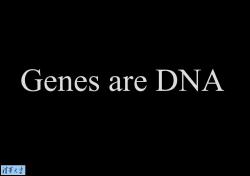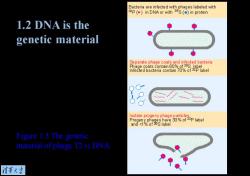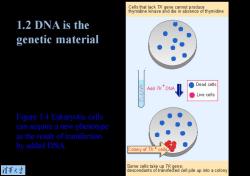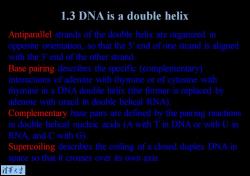清华大学:《分子生物学》课程PPT教学课件(基因ene)第一章 基因是DNA(Genes are DNA)

Chapter 1 Genes are DNA 清革大当
Chapter 1 Genes are DNA

DNA是遗传物质 DNA为双螺旋 DNA的复制是半保留的 本章主要内容 通过碱基配对进行核酸杂交 突变改变了DNA的序列 突变集中于热点 顺反子是单个DNA片断 多重等位基因的种类 DNA的物理交换导致重组 遗传密码是三联体 细菌的基因和蛋白是共线性的 顺式作用点和反式作用分子 清苇大当 遗传信息可由DNA或者RNA提供
DNA是遗传物质 DNA为双螺旋 DNA的复制是半保留的 通过碱基配对进行核酸杂交 突变改变了DNA的序列 突变集中于热点 顺反子是单个DNA片断 多重等位基因的种类 DNA的物理交换导致重组 遗传密码是三联体 细菌的基因和蛋白是共线性的 顺式作用点和反式作用分子 遗传信息可由DNA或者RNA提供 本章主要内容

1865 Genes are particulate factors 1871 Discovery of nucleic acids 1.1 1903 Chromosomes are hereditary units Introduction 1910 Genes lie on chromosomes 1913 Chromosomes contain linear array's of genes 1927 Mutations are physical changes in genes 1931 Recombination is caused by crossing over 1944 DNA is the genetic material 1945 A gene codes for protein 1951 First protein sequence 1953 DNA is a double helix 1968 DNA replicates semiconservatively 1961 Genetic code is triplet Figure 1.1 A brief 1977 Eukaryotic genes are interrupted history of genetics. 1977 DNA can be sequenced 1995 First genome sequenced 清菜大当
Figure 1.1 A brief history of genetics. 1.1 Introduction

Genes are DNA 清苇大当
Genes are DNA

1.2 DNA is the genetic material Avirulent mutants of a virus have lost the capacity to infect a host cell productively,that is,to make more virus Transfection of eukaryotic cells is the acquisition of new genetic markers by incorporation of added DNA. Transforming principle is DNA that is taken up by a bacterium and whose expression then changes the properties of the recipient cell 情菜大兰
Avirulent mutants of a virus have lost the capacity to infect a host cell productively, that is, to make more virus. Transfection of eukaryotic cells is the acquisition of new genetic markers by incorporation of added DNA. Transforming principle is DNA that is taken up by a bacterium and whose expression then changes the properties of the recipient cell. 1.2 DNA is the genetic material

Pneumacoccustype Infe ction of mice Lve mouse dies 1.2 DNA is the smo oth baderia genetic material Heat-kiled mouse liv es smooth ba cteria Live mouse lN es rough baderia Mixture of Heat-kiled smo oth ba deria mouse des Live × rough bacteria Dead mouse has lve smooth bacteria Figure 1.2 The transforming “八入N principle is DNA Add to Ive rough baderia ■ 深■■ Transformation 清菜大当
Figure 1.2 The transforming principle is DNA. 1.2 DNA is the genetic material

Bacteria are infected with phages labeled with 32P()in DNA or with 35S (in protein 1.2 DNA is the genetic material Separate phage coats and infected bacteria Phage coats contain 80%of 355 label Infected bacteria contain 70%of 32P label Progelbel and <1%of 35S label Figure 1.3 The genetic material of phage T2 is DNA 清菜大当
Figure 1.3 The genetic material of phage T2 is DNA. 1.2 DNA is the genetic material

Cells that lack TK gene cannot produce thymidine kinase and die in absence of thymidine 1.2 DNA is the 密 密 象 genetic material 象 象 象 Add TKDNA Dead cells Live cells Figure 1.4 Eukaryotic cells 能 卷 参 can acquire a new phenotype 验 as the result of transfection by added DNA Colony of TK+cells 清菜大当 Some cells take up TK gene; descendants of transfedted cell pile up into a colony
Figure 1.4 Eukaryotic cells can acquire a new phenotype as the result of transfection by added DNA. 1.2 DNA is the genetic material

1.3 DNA is a double helix Antiparallel strands of the double helix are organized in opposite orientation,so that the 5'end of one strand is aligned with the 3'end of the other strand Base pairing describes the specific (complementary interactions of adenine with thymine or of cytosine with thymine in a DNA double helix (the former is replaced by adenine with uracil in double helical RNA) Complementary base pairs are defined by the pairing reactions in double helical nucleic acids (A with T in DNA or with U in RNA.and C with G】 Supercoiling describes the coiling of a closed duplex DNA in space so that it crosses over its own axis. 清菜大当
Antiparallel strands of the double helix are organized in opposite orientation, so that the 5′ end of one strand is aligned with the 3′ end of the other strand. Base pairing describes the specific (complementary) interactions of adenine with thymine or of cytosine with thymine in a DNA double helix (the former is replaced by adenine with uracil in double helical RNA). Complementary base pairs are defined by the pairing reactions in double helical nucleic acids (A with T in DNA or with U in RNA, and C with G). Supercoiling describes the coiling of a closed duplex DNA in space so that it crosses over its own axis. 1.3 DNA is a double helix

5 1.3 DNA is a double helix Nucleotide subunit P yrimidine base F1gure【.5 A polynucleotide Purine base chain consists of a series of 5 C-3c sugar-phosphate links that form a backbone from which the bases Sugar-phosphate backbone protrude 清菜大当 3
Figure 1.5 A polynucleotide chain consists of a series of 5¢-3¢ sugar-phosphate links that form a backbone from which the bases protrude 1.3 DNA is a double helix
按次数下载不扣除下载券;
注册用户24小时内重复下载只扣除一次;
顺序:VIP每日次数-->可用次数-->下载券;
- 清华大学:《分子生物学》课程PPT教学课件(基因ene)绪论 Molecular Biology(主讲:王钊).ppt
- 河北农业大学:《分子生物学》课程教学资源(PPT课件)第十二章 免疫多样性产生的机制.ppt
- 河北农业大学:《分子生物学》课程教学资源(PPT课件)第十一章 病毒的分子生物学.ppt
- 河北农业大学:《分子生物学》课程教学资源(PPT课件)第十章 遗传重组.ppt
- 河北农业大学:《分子生物学》课程教学资源(PPT课件)第九章 真核生物基因表达调控.ppt
- 河北农业大学:《分子生物学》课程教学资源(PPT课件)第八章 原核生物基因表达调控.ppt
- 河北农业大学:《分子生物学》课程教学资源(PPT课件)第七章 蛋白质翻译(Protein Translation).ppt
- 河北农业大学:《分子生物学》课程教学资源(PPT课件)第六章 RNA转录(RNA transcription).ppt
- 河北农业大学:《分子生物学》课程教学资源(PPT课件)第五章 DNA损伤、修复和突变.ppt
- 河北农业大学:《分子生物学》课程教学资源(PPT课件)第四章 DNA复制(DNA Replication).ppt
- 河北农业大学:《分子生物学》课程教学资源(PPT课件)第三章 有机体、染色体和基因.ppt
- 河北农业大学:《分子生物学》课程教学资源(PPT课件)第二章 DNA的结构.ppt
- 河北农业大学:《分子生物学》课程教学资源(PPT课件)第一章 绪论.ppt
- 《微生物学》课程教学资源(参考资料)微生物基本术语(英汉对照词汇).pdf
- 南京师范大学:《微生物学》课程PPT教学课件(实验指导)实验九 噬菌体的分离.ppt
- 南京师范大学:《微生物学》课程PPT教学课件(实验指导)实验八 微生物的生理生化反应.ppt
- 南京师范大学:《微生物学》课程PPT教学课件(实验指导)实验七 环境因素对微生物的影响.ppt
- 南京师范大学:《微生物学》课程PPT教学课件(实验指导)实验六 微生物的接种技术及分离纯化.ppt
- 南京师范大学:《微生物学》课程PPT教学课件(实验指导)实验五 培养基的制备、器具包扎和灭菌.ppt
- 南京师范大学:《微生物学》课程PPT教学课件(实验指导)实验四 微生物的显微镜直接计数法和大小的测定.ppt
- 清华大学:《分子生物学》课程PPT教学课件(基因ene)第二章 从基因到基因组(From Genes to Genomes).ppt
- 清华大学:《分子生物学》课程PPT教学课件(基因ene)第三章 有多少基因(How many genes are there).ppt
- 清华大学:《分子生物学》课程PPT教学课件(基因ene)第四章 簇和重复(Clusters and repeats).ppt
- 清华大学:《分子生物学》课程PPT教学课件(基因ene)第五章 信使RNA(Messenger RNA).ppt
- 清华大学:《分子生物学》课程PPT教学课件(基因ene)第六章 蛋白质合成(Protein synthesis).ppt
- 清华大学:《分子生物学》课程PPT教学课件(基因ene)第七章 遗传密码的利用(Using the genetic code).ppt
- 清华大学:《分子生物学》课程PPT教学课件(基因ene)第八章 蛋白质定位(Protein localization).ppt
- 清华大学:《分子生物学》课程PPT教学课件(基因ene)第九章 转录(Transcription).ppt
- 清华大学:《分子生物学》课程PPT教学课件(基因ene)第十章 操纵子(The operon).ppt
- 清华大学:《分子生物学》课程PPT教学课件(基因ene)第十一章 噬菌体的战略(Phage strategies).ppt
- 清华大学:《分子生物学》课程PPT教学课件(基因ene)第十二章 复制子(The replicon).ppt
- 清华大学:《分子生物学》课程PPT教学课件(基因ene)第十三章 DNA复制(DNA replication).ppt
- 清华大学:《分子生物学》课程PPT教学课件(基因ene)第十四章 重组和修复(Recombination and repair).ppt
- 清华大学:《分子生物学》课程PPT教学课件(基因ene)第十五章 转座子(Transposons).ppt
- 清华大学:《分子生物学》课程PPT教学课件(基因ene)第十六章 逆转录病毒和逆转座子(Retroviruses and retroposons).ppt
- 清华大学:《分子生物学》课程PPT教学课件(基因ene)第十七章 DNA的重新排列(Rearrangement of DNA).ppt
- 清华大学:《分子生物学》课程PPT教学课件(基因ene)第十八章 染色体(Chromosomes).ppt
- 清华大学:《分子生物学》课程PPT教学课件(基因ene)第十九章 核小体(Nucleosomes).ppt
- 清华大学:《分子生物学》课程PPT教学课件(基因ene)第二十章 转录的起始(Initiation of transcription).ppt
- 清华大学:《分子生物学》课程PPT教学课件(基因ene)第二十一章 转录的调控(Regulation of Transcription).ppt
